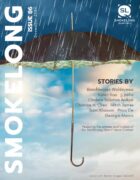So much of this story is about what everyone isn’t saying. And the story itself leaves so much unsaid. Why did you decide to frame the piece around the idea of silence?
I started this flash with an image of town people standing apart at a funeral, and a persistent question, Why are they doing that? I’d cut more than half of my initial drafts because flash is at its most powerful when it is up to the reader to unearth the deeper meaning of a story from carefully chosen words or images. This doesn’t come naturally to me. In my initial drafts, I pour out every image, every moment, every dialogue, every backstory that comes to me, this helps me understand my story and the characters. In my later drafts, I assign time for things I’m going to leave out intentionally. And this flash is literally about what people are not saying, so I carefully chose which images to reveal, the images that have the most underlying truth that turns this simple tale into a meaningful one.
I found the moment where the child narrator observes everyone standing apart to be such a revealing one. There is a sense of community about attending the funeral, but also so much separation as well. How did you come to that moment in the story?
This story happens in Tiya, a small town in Ethiopia. Two years ago, I attended a funeral in this town where I didn’t know the man who died—it’d have been rude not to go to the funeral in the town of less than five thousand people. I was in town to reimagine the ideas and stories I was working on for my then work-in-progress story collection set in Tiya. Characters fighting centuries-old tradition and/or culture is the thread tying my stories beyond the setting. At the funeral, inside a church, the townspeople stood apart, and I was struck by how strange it was, because in Ethiopia, we’re loud at funerals. I wanted to capture this moment, the way the town people stood, facing the church, eyes on the grass, dutifully, for hours as the priest read from his Bible. Nobody said a word, but as an outsider—I live in the city—I thought their silence spoke volumes. Look at me! I’m abiding by tradition! That’s when the idea for this flash was born.
I love the barking dog being described as “the only one not lying in the entire church.” Was the dog always in the story or did that come to you later?
The dog came in my later drafts. In my initial drafts, the little girl feels shame for admitting to herself that she’s glad the man is dead, but this revelation didn’t feel true to the story—because the girl grew up in the small town, like everybody else, where she was taught not to say bad things about the dead. I let the story sit—I’ve learned to be patient with a story, to let it sit in my desktop, even if it’s for a long time. This pays off in the most surprising ways. I was reading Merle’s Door by Ted Kerasote, a memoir about the love of a man for a dog and a dog for a man. While reading, I remember thinking, wait a minute, dogs don’t lie. I saw a dog in my flash, a dog who belonged to the bad man. This dog yelled at me to look, to believe what he is doing. I remember putting down the memoir and writing the scene where the dog disrupts the funeral. The narrator’s revelation, after I added the dog scene, felt organic—because now she watches the dog showing what he’s actually feeling.
The story seems to be reaching for a truth that by the end is finally revealed. How do you handle pacing and narrative propulsion in your flash stories?
Flash, for me, is challenging. Don’t get me wrong, I love the challenge, but maybe because I write more short stories than flash, it takes me a long time—months, years even—to get the pacing right. Through rewriting several drafts (“These Things We Not Saying” had seven complete drafts) I reach that place where I can see the not obvious narrative becoming obvious, and a clear image on how to structure my piece. And in my later drafts, I impose boundaries on my flashes. Time frame? Setting? Action? These questions help me draw out the “right” pacing for my flashes.
Speaking of the last line, the child narrator’s revelation at the end is a gripping moment. What inspired this ending?
A voice journal exercise I learned from James Scott Bell’s How to Write Dazzling Dialogue book. I asked the girl narrator a series of questions. Why do you call the man a bad man? Even if I, as a writer, knew the answer, I wrote an answer in the voice of the narrator. How do you feel about the bad man being dead? Why do you feel that? When I do this Q & A, I don’t know what I’m looking for—and that’s good because I always get something I didn’t plan ahead, a distinct pattern of speech, a hidden need or agenda, a dialogue that surprises me. When I let my narrator talk, she said, I glad the bad man dead. When I, as a woman whose mother is born in Tiya where tradition runs deep, as someone who travels to the town and witnesses how the town people behave, collectively, in many of the things they do, sputtered with surprise, my narrator told me, the bad man deserve dying that way. Later, when I read the story, this dialogue, like a final thread that binds the whole thing together, felt right for the story’s ending.



 The core workshop of SmokeLong Fitness is all in writing, so you can take part from anywhere at anytime. We are excited about creating a supportive, consistent and structured environment for flash writers to work on their craft in a community. We are thrilled and proud to say that our workshop participants have won, placed, or been listed in every major flash competition. Community works.
The core workshop of SmokeLong Fitness is all in writing, so you can take part from anywhere at anytime. We are excited about creating a supportive, consistent and structured environment for flash writers to work on their craft in a community. We are thrilled and proud to say that our workshop participants have won, placed, or been listed in every major flash competition. Community works.